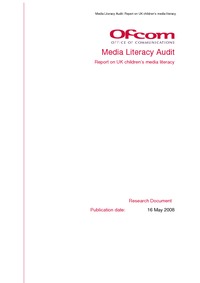Media Literacy AuditReport on UK children’s media literacy
|

|
 Diese Seite wurde seit 9 Jahren inhaltlich nicht mehr aktualisiert.
Unter Umständen ist sie nicht mehr aktuell.
Diese Seite wurde seit 9 Jahren inhaltlich nicht mehr aktualisiert.
Unter Umständen ist sie nicht mehr aktuell.
 Zusammenfassungen
Zusammenfassungen
 The promotion of media literacy is a responsibility placed on Ofcom by Section 11 of the Communications Act 2003. Ofcom’s definition of media literacy, developed after formal consultation with stakeholders is ‘the ability to access, understand and create communications in a variety of contexts’. This report is structured according to the elements in this definition.
The promotion of media literacy is a responsibility placed on Ofcom by Section 11 of the Communications Act 2003. Ofcom’s definition of media literacy, developed after formal consultation with stakeholders is ‘the ability to access, understand and create communications in a variety of contexts’. This report is structured according to the elements in this definition.Accessincludes take-up of media devices, volume and breadth of use. Understand includes interest and competence in using the features available on each platform, extent and levels of concern, trust in television and online content and use of television and internet security controls.
Create includes people’s confidence in engaging with creative content and their interest in carrying out creative tasks, most notably using social networking sites.
Children are among the most enthusiastic and engaged groups in society in terms of their consumption of a wide range of media. Homes containing children are significantly more likely to have access to a wider range of technologies than homes that do not. Our analysis also demonstrates that age, gender and socio-economic group are key determinants of which types of media are used, where they are used and how they are used.
In understanding children’s media literacy, it is important to consider the context in which they are consuming media, particularly at home. For this reason we capture and track detailed information about what devices children have at home, either in shared areas or in their own bedroom, and how they use and regard this equipment. Where possible, we also explore out-of-home use.
The in-home media landscape has continued to develop at a rapid pace in recent years, with access to, and use of, the internet in particular increasing significantly since the last Audit. As the nature of children’s access to media changes, so do the ways in which children consume and combine media. In the first part of this report we discuss these changes, and explore which groups are most affected and why.
 Dieses Buch erwähnt ...
Dieses Buch erwähnt ...
 Begriffe KB IB clear |  Kinder Kinder children
, children
,  Kommunikation Kommunikation communication
, Medienkompetenz/media literacymedia literacy communication
, Medienkompetenz/media literacymedia literacy
|
 Dieses Buch erwähnt vermutlich nicht ...
Dieses Buch erwähnt vermutlich nicht ... 
 Nicht erwähnte Begriffe | Eltern |
 Zitationsgraph
Zitationsgraph
 Zitationsgraph (Beta-Test mit vis.js)
Zitationsgraph (Beta-Test mit vis.js)
 2 Erwähnungen
2 Erwähnungen 
- Medienpädagogik - Ein Studienbuch zur Einführung (Daniel Süss, Claudia Lampert, Christine Wijnen) (2009)

- Regelstandards informatische Bildung in der Volksschule des Kantons Solothurn - Wegleitung und Empfehlungen (imedias) (2014)


 Volltext dieses Dokuments
Volltext dieses Dokuments
 |  Media Literacy Audit: Gesamtes Buch als Volltext ( Media Literacy Audit: Gesamtes Buch als Volltext ( : :  , 582 kByte; , 582 kByte;  : :  Link unterbrochen? Letzte Überprüfung: 2020-11-28 Letzte erfolgreiche Überprüfung: 2011-11-13) Link unterbrochen? Letzte Überprüfung: 2020-11-28 Letzte erfolgreiche Überprüfung: 2011-11-13) |
 Anderswo suchen
Anderswo suchen 
 Beat und dieses Buch
Beat und dieses Buch
Beat hat dieses Buch während seiner Zeit am Institut für Medien und Schule (IMS) ins Biblionetz aufgenommen. Beat besitzt kein physisches, aber ein digitales Exemplar. Eine digitale Version ist auf dem Internet verfügbar (s.o.). Aufgrund der wenigen Einträge im Biblionetz scheint er es nicht wirklich gelesen zu haben. Es gibt bisher auch nur wenige Objekte im Biblionetz, die dieses Werk zitieren.










 Biblionetz-History
Biblionetz-History